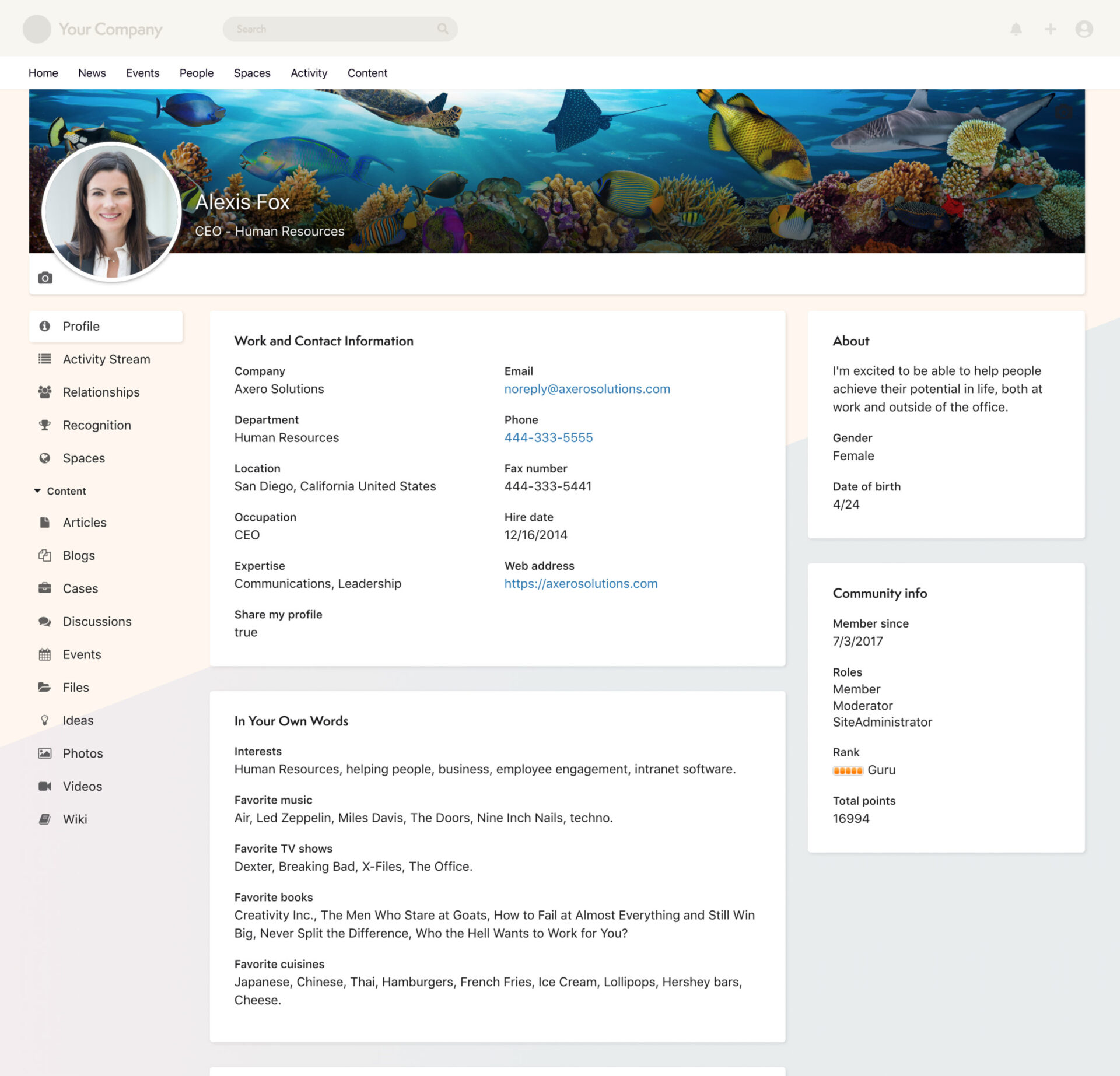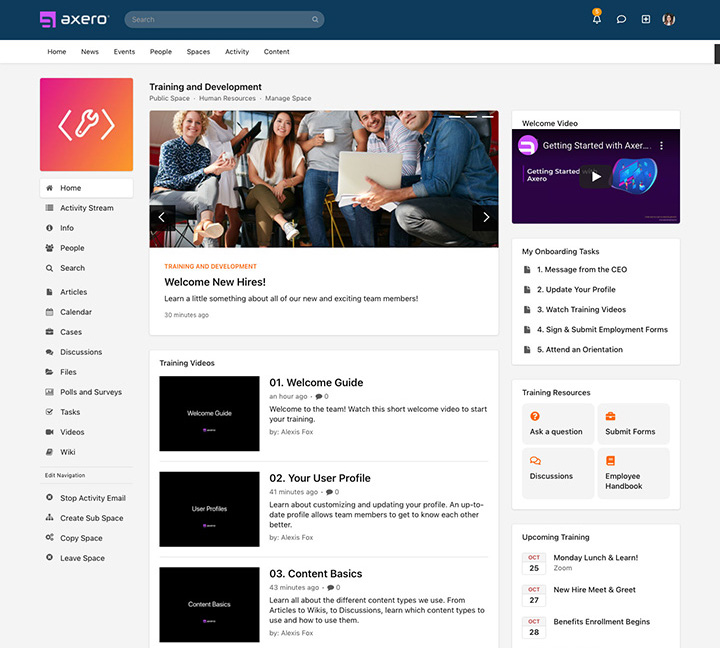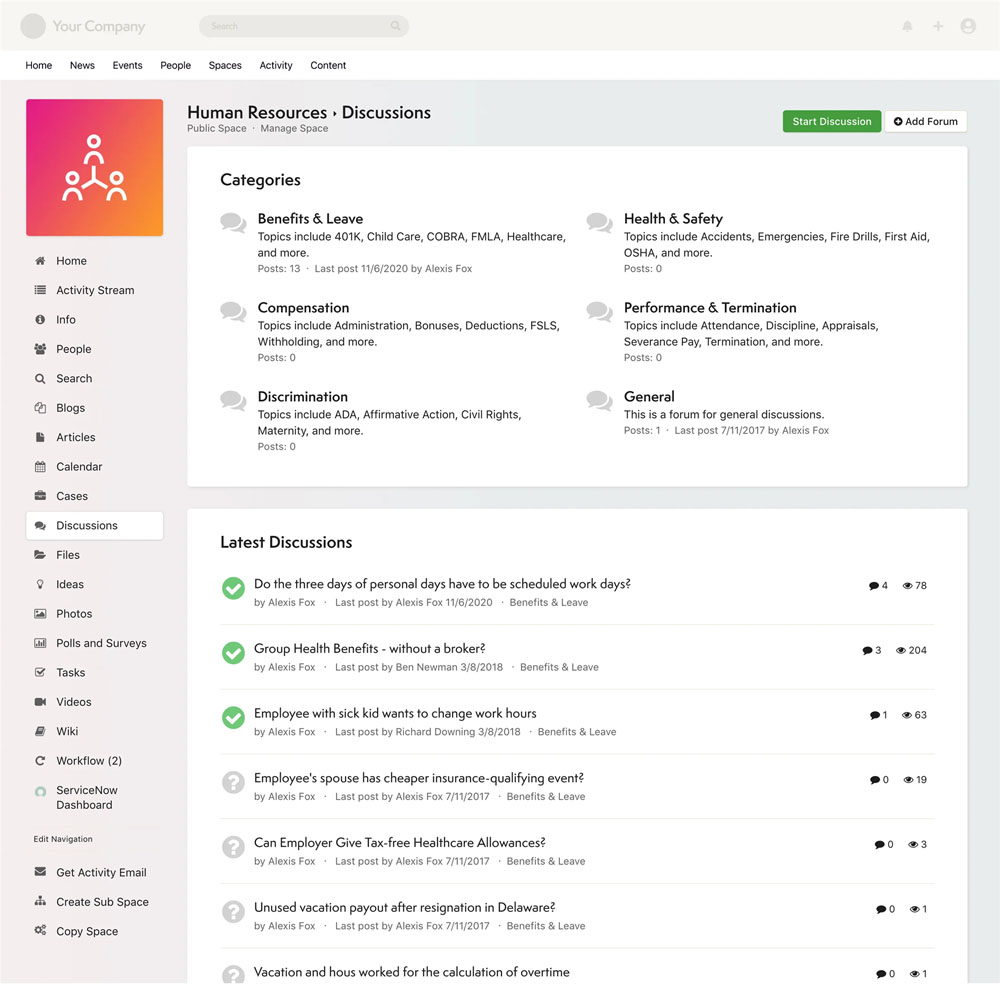The knowledge your company accumulates is your primary competitive advantage. No one has the experiences and insights that you do. There’s no reason to make this wealth of understanding difficult to find, especially for people who actually need to access and use it almost every day—your employees.
Think of a knowledge base as your company’s personal Google—everything pertinent to daily operations is searchable and always accessible. This increases efficiency and productivity because employees can find what they need, no matter where they are. When it comes to what you use for your online knowledge base, your intranet is the perfect solution—as long as it supports knowledge management.
What is the purpose of a knowledge base?
A knowledge base is a company’s repository where all internal information is organized. It’s the best option to store customer data, market reports, product details, and employee documents, to name a few. A knowledge base allows employees quick, secure access to important information so that teams can address customer service issues, resolve problems, and gain insights for collaboration in the workplace.
With intranet software like Axero, you have a host of intuitive search indexes and collaboration tools while supporting a more focused staff by storing internal information in the same place where employees get stuff done (i.e., communications with colleagues, company announcements, and answers to questions).
One less platform for your people to shuffle through means more time saved. Centralize what different departments need and watch customer satisfaction and retention improve, profits grow, and happier employees take ownership of their roles. It’s amazing what you can do when you organize your information so that people can find what they’re looking for.
Here are 12 essential tips to create the best online knowledge base for your company.
1. Capture and reuse knowledge
Strong knowledge base software allows your company to take knowledge-centered approaches in every aspect of your business, such as customer support, employee training, and employee onboarding. That’s why you want your knowledge base filled with relevant, up-to-date information and resources that are created with your employees in mind. Consider adding frequently asked questions (FAQs), important issues and topics, and guides for different teams in your company.
You’ll also simplify many other processes that require information sharing by using online collaboration tools. This type of knowledge management strategy is designed to help your departments work more efficiently. Your customer support reps can find similar cases they’re working on, new employees can find onboarding checklists and training guides, and your sales team can find email templates to handle sensitive deals. To have a strong online knowledge base, you need to make sure your content is relevant and easy to find. Care about the methodologies and practices you use to capture, structure, use, and reuse knowledge—your employees will thank you.
2. Make it easy
To make your company knowledge base a true resource for your people, your content should be easy to digest. Think about who the content is for and what the purpose is. For instance, if you’re creating a document about common customer support questions, you might want to formulate your information as a Q&A. Other teams, like your legal department, might require documents that are more detailed. It’s not enough to throw a bunch of documents into your knowledge bases with no plans for structure or workable search functionality.
Go through your content with a fine-tooth comb. The information you provide your employees needs to be easy to read and support their specific needs.
3. Address common questions
Do your team members face similar issues in their departments? Chances are, the answer is yes. If so, provide that insight and employee experience in your online knowledge base. This can be in the form of an FAQ page, cases, or wikis. Building a knowledge base works best when you document the solutions to common issues or situations.
4. Keep your company knowledge base fresh with new content
Ideally, your online knowledge base should be updated with new information, or your employees won’t get and find much value from it. It needs to have new insight and data whenever there is new information available.
How many deals did you close in Q2 of last year?
Did you have any new project releases?
What were the results of your customer happiness survey?
Do you have spreadsheets of marketing material for your sales team?
This is all information that should live in your knowledge management system.
It helps your employees do their jobs well, stay informed about your company’s progress, and reduce bottlenecks and silos. Encourage employees to be part of your knowledge base. As employees interact with your knowledge base, they can continuously review information and add feedback by using social features.
If there are errors, anyone—or a select few—can update the content or bring it to the attention of a higher-up. This approach keeps your knowledge base at its finest, while inviting your employees to work as a community and take part in your company’s overall growth.
5. Share knowledge base articles to maintain peak performance
If you don’t continuously evolve as a company, you’ll likely fall behind. That’s why it’s important to encourage collaboration, listen to ideas, and keep your employees sharp with resources relevant to their jobs.
Your online knowledge base can store these articles for everyone to access today, tomorrow, or months from now. Enable your people to comment, like, and share content with team members or other departments. You’ll create an inviting community that supports personal growth for every member in your organization. Have pre-made templates handy when employees want to get involved with writing knowledge base articles. This way, employees can easily contribute to your intranet while keeping their work uniform.
6. Create a simplified, streamlined management structure
The content inside your company knowledge base has to be searchable, whether you are using AI like our Axero Copilot to power these searches or just good old human intuition. Streamlined navigation will take your user experience to the next level. This way, your employees will easily capture, share, and update information.
7. Encourage content creation and collaboration
Your online knowledge base can streamline external communications with potential leads, current customers, and visitors on your public website, because information is readily available for everyone.
Encourage your employees from different teams to create blogs and articles for marketing purposes. This keeps your staff educated about different factions in your company and answers questions for your customers, immediately. Your customer support team can publish FAQ articles. Your communications team can show off your expertise by creating posts about industry topics. If you use your knowledge to provide excellent experiences for customers, it shows.
8. Spark conversations
Knowledge management software encourages your employees to add their insight and contribute to your thriving community. By enabling social features in your platform, everyone in your organization can engage with each other and their work.
Let’s say one of your superstar sales reps created an article about handling difficult situations with customers. A new sales rep reads the article and finds it useful. Hooray! They give the article a like. Then an OG salesperson, who’s been working for your company for a decade, noticed some key points were missing and left a comment for the author to add them. Just like that, your employees are engaging, learning, and growing—together.
9. Customize pages with your company branding
Adding your company’s branding to your online knowledge base takes little effort but has powerful effects. When you incorporate your logo or company colors, your content becomes more engaging. It also aligns your employees closer to your organization and makes them feel like part of the team.
Take pride in the tools you provide your employees, and they will take pride in the work they create with your resources.
10. Use employee profiles
Take a moment and imagine what your perfect internal knowledge base looks like. You might be picturing documents, the employee handbook, reports, spreadsheets, and notes. At the end of the day, this information that makes up your online knowledge base is comprised of the experiences and work contributed by your employees.

A robust employee directory will create connections—a powerful way to exchange knowledge in your organization. Urge your staff to fill out their employee profiles completely. Go beyond the standard questions and also include personal interests and past experiences. Use personal activity streams so others can see who’s working on what and can ask questions.
11. Integrate your knowledge base into your intranet
Your intranet is the perfect home for your company’s internal knowledge because it simplifies how your employees do their jobs. When everything lives in one place, employees don’t waste time searching for files, bouncing between different platforms, or accidentally viewing older versions of documents. They can even collaborate on the same document.
Caring about your online knowledge base is caring about the internal growth of your company. When you provide your staff with valuable knowledge management tools that streamline their day-to-day, productivity soars.
12. Always find ways to improve
To maintain effective internal knowledge bases, you need to treat it like a growing, living system that needs to evolve over time. Look for ways to improve. We recommend talking to your employees—they are the ones who understand firsthand what’s working and what could use tweaking.
Create meaningful employee surveys or schedule small team meetings with managers to get constructive feedback. If your employees are already receiving a lot of emails and meetings, there are other ways to gauge what’s working. You can also track member activity by using your analytics tool. Understand what content receives the most views and engagement. Your online knowledge base grows with your company. Therefore, it’s important to check in throughout the year.
Get your knowledge organized with Axero
When building the best internal knowledge management process, it’s important to always keep your employees in mind. After all, they are the ones who will be using it. When information is readily available and employees are encouraged to contribute to this growing body of knowledge, your staff is empowered to take pride in their role.
A well-organized online knowledge base will save your organization money by reducing the time spent trying to find information. It ensures efficiency for all business fronts—your customer inquiries, employee training, and collaboration. It is one of the most cost-effective support channels because it gives customers easy access to information that would otherwise require contact with the company’s staff.
Create the comprehensive knowledge base of your dreams with Axero. Our platform centralizes all knowledge in your business to create a one-stop shop for any query your employees might want to know, and our AI search tool, Copilot, makes navigation and search easier than ever. Book a demo today to find out more.













